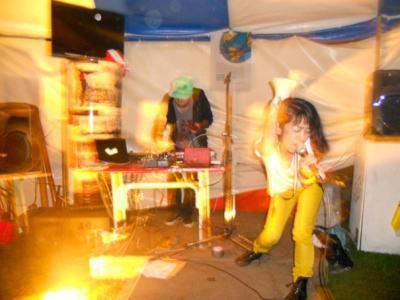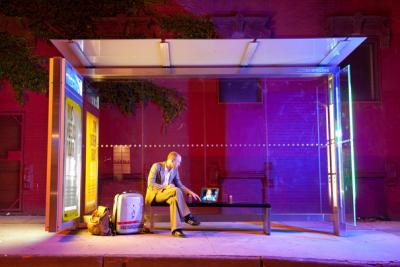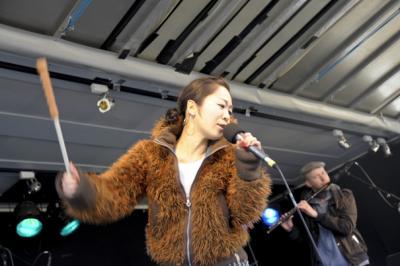Japanische Pop-Inszenierungen
Heute an den Thementagen «Musik und Globalisierung»: Japanische Sprechgesänge und Girlie-Melodien interagieren mit knackiger Elektronika, tiefen Bass-Beats und einem Schuss Indie Rock. Das zweite Album von Tim & Puma Mimi.
Michiko Hanawa (Puma Mimi) und Christian Fischer (Tim) trafen sich in Amsterdam. Puma Mimi studierte Museologie und Tim Kunst. Er produzierte eher «düstere» bis «experimentelle» elektronische Musik und spielte bei Seelenluft und Märklin. «Ich solle mal auf japanisch singen, fragte er mich», erinnert sich Puma Mimi: «Bislang hatte ich allerdings bloss in einer drittklassigen japanischen Punk-Band gesungen, und dort immer in schlechtem Englisch». Tim wollte schräge japanische Musik hören: «Ich hatte dieses Klischee im Kopf, von schräger japanischer Kunst und Popkultur. Dieses Freche, Frische und Direkte wäre ein spannender Kontrast zu meiner Musik.»

Heute sind Puma Mimi und Tim verheiratet und leben in Zürich. Länger haben sie vor allem via Skype kommuniziert, geprobt, und sie sind auch live aufgetreten - Tim auf irgendeiner Bühne in Zürich, Amsterdam oder New York, Puma Mimi zuhause in Tokio. Mit «The Stone Collection of Tim & Puma Mimi» (Mouthwatering Records) geben die beiden jetzt ihr zweites Album heraus. Das Rezept funktioniert: Japanische Sprechgesänge und Girlie-Melodien interagieren mit knackiger Elektronika, tiefen Bass-Beats und einem Schuss Indie Rock. Quere Klavierpassagen, Steeldrum-Klänge, eine Querflöte und ein Hackbrett spielen dazwischen. Musikalische Vielfalt und Direktheit passen zum Zeitgeist, die kunstvollen Videoclips und Pressefotos auch. Ein stimmiges Gesamtprodukt.
Das Album
Ausschnitte aus dem Interview
The Beginnings
[Michiko Hanawa]: Christian said, could you sing something in Japanese? And I said, why not? Actually, I’ve never sung in Japanese. In my Japanese pop punk band, I sang in English, broken English, but English, which I thought was cooler than Japanese. I have never sung in Japanese.

Japan-Image
[MH]: I buy colorful clothes for Pumi Mimi, but not for me. Michiko Hanawa and Puma Mimi are the same person, but I exaggerate a little bit to make Puma Mimi funnier.
[Christian Fischer]: The funny thing is that in the beginning you were completely against all that. Michiko played in a punk band before and once she showed me a video and they were all dressed black and didn’t move at all on stage, just standing there and playing and I was like come on if you play concerts I want you to have like colorful clothes and makeup.
[MH]: He had this weird image in mind of Japanese pop singers, with really weird clothes – so I first had to tell him that not all Japanese are like that.

Skype Concerts
[MH]: We made these skype concerets, Christian in a club in Switzerland, Berlin and New York, and I’m singing from Japan in the kitchen alone to the computer, to the Skype and then that will be projected on Christian’s side, the big screen in the club. So it’s a long-distance live show.
[Thomas Burkhalter]: In these events were you the private Michiko or Puma Mimi?
[MH]: Oh, that was a very difficult part. If you have a real show, then you know I will be on stage. Audience is there and then let’s party. But in the Skype concert, it’s usually like 6, 7 o’clock in the morning in Japan. And so I just wake up and still feel like dizzy and then drink coffee and then suddenly the team calls me and then okay, let’s start the show. I’m like, oh, oh, where am I. And so it was the most difficult part of these Skype shows for me. The first one or two shows I was bit stiff on the screen I think. I didn’t know how much I can move from the screen because sometimes the projector is quite slow, and delayed. So if I move too much then I’m just like a blur on the screen. So I tried to stand still and just singing like news, Nachrichten, yeah.
[TB]: Did you were the stage costume?
[MH]: No, sometimes the pajama. And I hang stuff in the back, so you don’t see the messy apartment too much. And sometimes the tea cup also was in the picture. So people can see Mimi drinking tea or coffee.
[CF]: Once we could even show the sunrise. That was really nice. It was in Helsinki Club and we had to play two sets. So we had half an hour in between which was just the right moment for sunrise. So Mimi could turn the computer to the window and you could see the skyscraper and then the sun coming up. It was funny to have this in a club at 11 at night. At that moment people started to believe it’s real.
[TB]: How does it work technically?
[CF]: The thing is that we are an electronic band and Michiko hears only the playback. I send her the beat, and she sings to this beat and then only her voice comes back. We have around one second delay. And then the same beat from the playback is played to another channel. And in this channel, I adjust the delay. So if I press play on the playback, it goes first to Japan, and then maybe with one second delay, it comes here also on stage and then we can play to this playback like the drummer plays what he hears from the playback and I try to fit in Michiko’s voice to this till I sing and often it works good. But if it didn’t work good, it was also interesting because then people believed that it’s not a fake. Once I played in New York in a small club and I was in the middle and around, it was just couches, and some friends invited friends from a New Media School and the connection was really bad. The picture was always like hanging and then just some parts of the picture were renewed and I was like, shit, it’s so bad today. And all these New Media guys are sitting in front of me. I was really a bit ashamed and then in the end I asked them, how did you like? Wasn’t it too chaotic with this bad connection? No, it was great. All this distortion on the image, I mean other guys do it with visual thing with extra distortion and in your case it has to be like this.

Biography
Biography
Biography
Published on May 29, 2012
Last updated on August 12, 2020
Topics
What’s the idea behind a traditional brass band from Vienna playing at 5 am in the morning? How does physical presence of artists affect the music they play?
How artists deal with the practice that some call «time-travel» and others «audiotopia».